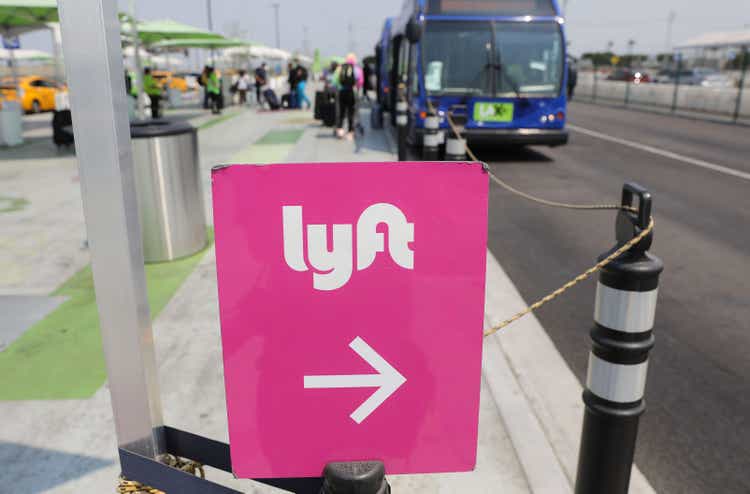Mario Tama/Getty Images News
Updates to add CEO quotes from interview, context on drivers
Class A shares of Lyft (NASDAQ:LYFT) on Tuesday rocketed in extended trading, after the ride-hailing firm said it would generate positive free cash flow for a full year for the first time.
LYFT stock soared as much as 66.9% after hours, and was last up 15.8% to $13.70. It is worth noting that LYFT has a 13.74% short interest – 47.71M shares out of a public float of 332.63M shares.
The company’s forecast comes a week after larger rival Uber (UBER) delivered its first profitable year. The results from the two market leaders show that demand for ride-sharing remains strong, despite concerns over regulatory scrutiny and more demands by drivers for wages.
For Q4 2023, Lyft’s (LYFT) net loss narrowed to $26.3M from a net loss of $588.1M a year ago. Its revenue rose 4% Y/Y to $1.2B, helped by a 17% rise in gross bookings to $3.7B.
The company clocked 191M rides in Q4, its fourth consecutive quarter of increasing growth, while its active riders came in at 22.4M. For the full year 2023, rides were 709M, up 18% Y/Y.
Lyft’s (LYFT) results come a day before a planned strike by drivers represented by Justice for App Workers – a national coalition of more than 130K ride-share drivers and delivery workers. The drivers will not take rides to and from any airport in 10 major cities, as they look for fair wages, safety and more.
Incidentally, Lyft (LYFT) last week addressed complaints about pay transparency with an announcement that its drivers would be ensure of earnings at least 70% of rider fares each week after the deduction of external fees.
“(The Valentine’s Day strike) has been scheduled now for many many weeks. The reason I say that is because it actually came out before (our) earnings guarantee, and if you look at that earnings guarantee … we’re actually responding to a lot of what they’re asking for ourselves. So, you know, we’ll kind of see where that goes, hard to predict,” LYFT top boss David Risher told Seeking Alpha in an interview.
“There are really two things that I hear about from (drivers) all the time … one is I want more transparency, I want to understand what the breakdown is and (two) I really don’t like it when riders get in the car and they say I’ve paid 50 bucks and I feel like Lyft (LYFT) is taking too big a share,” Risher added.
According to the CEO, the company over the second half of last year paid its drivers $30.68 gross per hour for engaged time.
Turning to Lyft’s (LYFT) guidance, the company sees Q1 2024 gross bookings of about $3.5B to $3.6B and adjusted EBITDA of $50M to $55M.
However, it was its full year guidance that grabbed attention. Based on a forecast of rides growth in the mid-teens, slightly faster that rides growth for gross bookings and an adjusted EBITDA margin expansion of about 50 basis points, Lyft (LYFT) anticipates generating positive free cash flow for full year 2024. That would be a first for the company.
When asked about when Lyft (LYFT) would achieve profitability, chief executive Risher said: “I can’t give you a timeline on that, it’s just not something we’re discussing, but I can absolutely say it is in the plan, it’s our focus for sure. And the fact that we’re going to be free cash flow positive across all of 2024 is another really good indication that financially we are really strengthening our business quite a lot.”
More on Lyft
Correction from source: LYFT has corrected its press release to say “50 basis points” as part of its full year adjusted EBITDA margin guidance instead of “500 basis points.” This story has been amended to reflect that correction.

